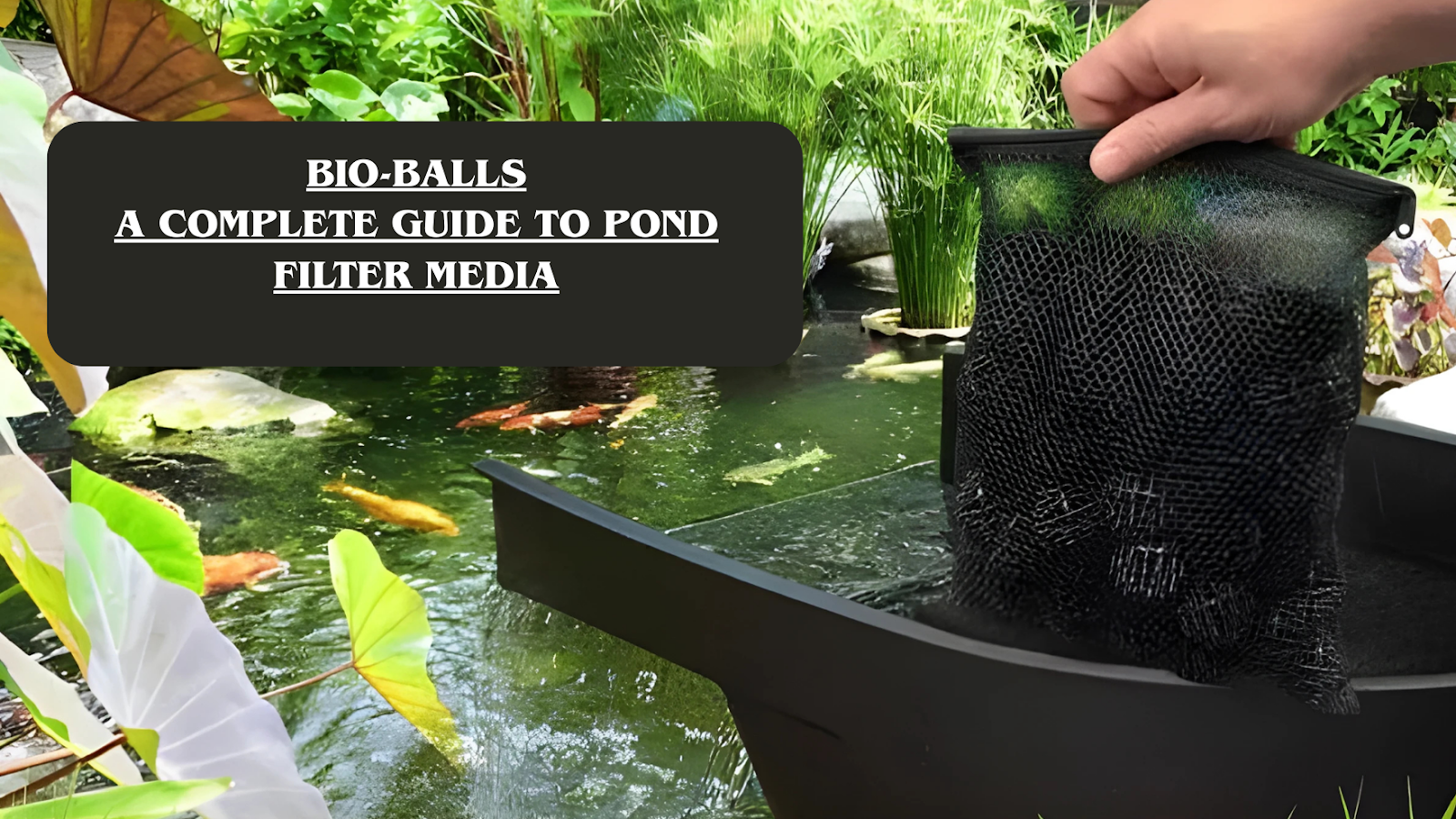Maintaining clear and healthy water in a pond is one of the biggest challenges for pond owners. Whether you have a decorative water garden, a koi pond, or a large fish-filled ecosystem, filtration is the key to keeping everything in balance. While pumps and mechanical filters remove debris, a proper biological filtration system is essential for breaking down harmful substances and supporting aquatic life. That’s where bio-balls come in.
In this complete guide, we’ll explain what bio-balls are, how they work, their advantages and disadvantages, and whether they are the right pond filter media for you.
What Are Bio-Balls?
Bio-balls are small, durable plastic spheres designed specifically to provide surface area for beneficial bacteria to grow. These bacteria play a vital role in the nitrogen cycle, helping to convert toxic fish waste (ammonia) into less harmful compounds like nitrites and nitrates.
Unlike mechanical filter pads or sponges, which primarily trap dirt and debris, bio-balls are focused on biological filtration. Their open, lattice-like design makes them excellent at housing colonies of nitrifying bacteria without clogging easily.
Bio-balls come in different shapes, sizes, and designs, but they all serve the same basic purpose: giving beneficial microbes a place to thrive.
How Do Bio-Balls Work in a Pond Filter?
The process is simple but powerful. When water flows over and around the bio-balls, several things happen:
- Water Contact: Pond water passes through the bio-balls, carrying dissolved waste such as ammonia and nitrites.
- Bacterial Colonization: The textured surfaces of the bio-balls provide shelter for bacteria, which break down these harmful substances into less toxic forms.
- Oxygen Exchange: Because bio-balls are usually used in “wet/dry” or aerated filter setups, oxygen levels remain high, supporting aerobic bacteria.
- Continuous Cycle: As long as the pond has fish producing waste and water circulating through the filter, the bacteria on bio-balls will keep working 24/7.
This natural cycle is what maintains stable and healthy water conditions for fish and plants.
Benefits of Using Bio-Balls
Bio-balls have been a trusted pond filter media for years. Here are their main advantages:
1. High Surface Area
Each bio-ball has a complex structure that maximizes surface area. The more surface available, the more bacteria can colonize and the stronger your biological filtration will be.
2. Long-Lasting and Reusable
Unlike sponges or filter pads that degrade over time, bio-balls are made of durable plastic and can last for many years. They don’t need frequent replacement, making them cost-effective in the long run.
3. Easy to Clean
Bio-balls don’t clog as easily as fine filter pads. When cleaning is needed, they can simply be rinsed in pond water (not tap water, which could kill beneficial bacteria).
4. Versatile Applications
They can be used in pond filters, aquarium sumps, trickle filters, waterfall boxes, and even DIY filtration systems.
5. Eco-Friendly Bacteria Support
By encouraging natural bacterial colonies, bio-balls reduce the need for chemical treatments or constant water changes.
Drawbacks of Bio-Balls
While bio-balls are effective, they’re not perfect. Consider these limitations:
- Not a Mechanical Filter: Bio-balls don’t trap fine particles or dirt, so they should always be paired with mechanical filtration like sponges or pads.
- Bulky in Size: Compared to ceramic media or bio-rings, bio-balls take up more space in a filter chamber.
- Require Good Water Flow: If water flow is poor, bio-balls won’t be as effective because bacteria need oxygen-rich conditions.
- Nitrate Accumulation: While bacteria convert ammonia → nitrite → nitrate, bio-balls don’t remove nitrates. Regular water changes or plants are needed to deal with this final stage.
Bio-Balls vs. Other Filter Media
When choosing pond filter media, bio-balls are just one of many options. Here’s how they compare:
- Bio-Balls vs. Sponges: Sponges provide both mechanical and biological filtration but clog faster. Bio-balls are lower maintenance and better for long-term bacteria housing.
- Bio-Balls vs. Ceramic Rings: Ceramic rings offer even more surface area per volume, making them ideal for smaller spaces. However, they can break down over time, unlike durable bio-balls.
- Bio-Balls vs. Lava Rock: Lava rock is inexpensive and porous, but it can harbor debris and be harder to clean. Bio-balls are easier to manage and more uniform in performance.
Best Practices for Using Bio-Balls
If you decide to add bio-balls to your pond filter system, here are a few tips for success:
- Pre-Filtration is Essential: Always use mechanical filter pads or brushes before water passes over bio-balls. This prevents them from getting clogged with debris.
- Use in Sufficient Quantity: The more fish you have, the more bio-balls you’ll need. A heavily stocked koi pond requires a larger biological filter.
- Do Not Over-Clean: Rinsing bio-balls too often, or with chlorinated tap water, can kill beneficial bacteria colonies. Instead, gently swish them in pond water when needed.
- Allow Time for Cycling: New bio-balls take weeks to fully establish bacterial colonies. Be patient and avoid overstocking your pond during this period.
- Combine with Plants: Aquatic plants work alongside bio-balls by absorbing nitrates, creating a balanced ecosystem.
Who Should Use Bio-Balls?
Bio-balls are a great choice for:
- Koi Pond Owners: Large fish produce a lot of waste, making bio-balls ideal for biological support.
- Water Garden Hobbyists: They help keep ornamental ponds healthy and clear without excessive maintenance.
- DIY Pond Builders: Bio-balls are easy to incorporate into homemade filter systems like barrels or waterfall boxes.
- Aquarium Keepers: While popular in ponds, bio-balls are also used in large aquariums and sumps.
Conclusion
Bio-balls may look simple, but they play a vital role in a pond filter system. Acting as a home for beneficial bacteria, they help maintain stable water chemistry, protect fish from harmful toxins, and reduce the need for chemical treatments. While they are not a complete solution on their own (you’ll still need mechanical filtration and nitrate management), bio-balls are one of the most reliable and low-maintenance forms of biological filter media available. If you want a long-lasting, reusable, and efficient way to keep your pond water clear and healthy, adding bio-balls to your pond filter is well worth considering.
FAQs: Bio-Balls for Pond Filters
1. What are bio-balls made of?
Bio-balls are usually made of durable, lightweight plastic. Some high-end versions may use BPA-free or UV-resistant plastics to ensure longevity in outdoor pond environments.
2. How do bio-balls work in a pond filter?
Bio-balls provide a large surface area for beneficial bacteria to grow. These bacteria convert toxic ammonia from fish waste into less harmful nitrites and nitrates, maintaining a balanced pond ecosystem.
3. Can I use bio-balls alone for pond filtration?
No. Bio-balls provide biological filtration but do not remove solid debris. It’s important to combine them with mechanical filters, such as sponges or brushes, to trap dirt and leaves.
4. How often should I clean bio-balls?
Bio-balls should be cleaned sparingly, only when they become visibly clogged. Always rinse them in pond water (not tap water) to avoid killing beneficial bacteria.
5. How long do bio-balls last?
With proper care, bio-balls can last 5–10 years or longer, making them a durable and cost-effective filter media.
Keep an eye for more latest news & updates on Daily!



